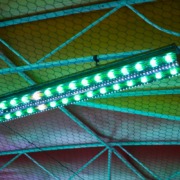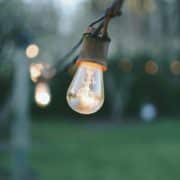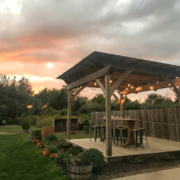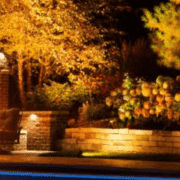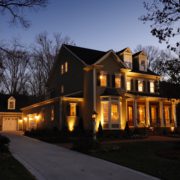Landscape Lighting Designs Principles: Expert Tips for a Stunning Outdoor Sanctuary
A well-designed and thoughtfully executed landscape lighting designs plan has the power to transform your outdoor living space into a magical sanctuary, enhancing both its beauty and functionality. By carefully combining various lighting techniques, fixture types, and design elements, you can create a dazzling, alluring environment that showcases your landscape’s best features while ensuring the safety and comfort of those who enjoy it. At Charlotte Lighting & Hardscapes, our experts specialize in crafting tailored landscape lighting designs that artfully elevate your outdoor space’s atmosphere, ambiance, and aesthetics.
The principles of landscape lighting designs encompass various aspects, such as fixture selection, placement, layering, and focus. By carefully considering these factors, you can create a harmonious and cohesive lighting plan that seamlessly blends with your home’s architectural style and landscaping. Additionally, well-planned landscape lighting can enhance your home’s security, deter intruders, and increase property value, making it an excellent investment for homeowners.
In this blog post, we will delve into the essential landscape lighting designs principles and share expert tips, ideas, and techniques to guide you in cultivating an enchanting outdoor space that perfectly complements your home. We’ll also explore different lighting fixture options, discuss creative ways to highlight architectural and natural features and provide guidance on ideal placement and layering of light.
By embracing these foundational landscape lighting designs principles and tapping into the expertise of our skilled team at Charlotte Lighting & Hardscapes, you can create an outdoor oasis that enthralls your senses, provides exceptional functionality, and beautifully showcases your home’s unique character. Let’s discover the world of landscape lighting designs and begin on your journey to crafting your dream outdoor living space.
Landscape Lighting Layering Techniques: Balancing Ambiance and Functionality
A successful landscape lighting layout begins with an understanding of the importance of balancing ambiance and functionality. By incorporating a combination of ambient, task, and accent lighting, you can create a visually appealing and practical environment that meets your outdoor space’s unique needs. Consider these layering techniques to achieve harmony and cohesion in your landscape lighting designs:
- Ambient Lighting: Establish general illumination throughout your outdoor space with the help of landscape bollards, post lights, or wall lights. These fixtures create a foundation for your lighting atmosphere and contribute to a comfortable level of brightness.
- Task Lighting: Ensure safety and practicality by incorporating task lighting in essential areas, such as pathways, steps, and outdoor cooking or dining zones. Use path lights, step lights, or hanging lights in these spots to provide targeted illumination.
- Accent Lighting: Add dramatic flair and visual interest by spotlighting architectural or natural features using accent lighting techniques. Uplighting, downlighting, or moonlighting can emphasize specific elements of your landscape, such as trees, sculptures, or water features.
Landscape Lighting Fixture Options: Choosing the Perfect Fit
Selecting the right landscape lighting fixtures is crucial for achieving the desired effect in your outdoor space. With a wide variety of options available, it’s essential to consider their purpose, style, and compatibility with your design aesthetic and landscape features. Here are the main fixture types and their roles in your landscape lighting layout:
- Path Lights: Illuminate walkways and garden beds with the help of path lights, which come in various designs, including traditional, modern, and rustic styles.
- Spotlights: Highlight architectural or landscape features with spotlights, which can be used for uplighting, downlighting, or other accent lighting techniques.
- Step Lights: Provide safe illumination for staircases and elevation changes with step lights, which can be recessed or surface-mounted.
- Underwater Lights: Enhance the beauty and ambiance of pools, ponds, or fountains with underwater lights, which must have weatherproof ratings suitable for submersible applications.
Landscape Lighting Designs Elements: Highlighting Your Outdoor Space’s Best Features
To create a captivating landscape lighting designs, carefully consider which architectural or natural features you want to emphasize. By focusing on unique or eye-catching elements, you can make your outdoor space truly shine. Here are some creative ideas for accentuating focal points:
- Architectural Features: Create drama and dimension by spotlighting your home’s façade, chimneys, columns, or other interesting architectural elements using spotlights or floodlights.
- Trees and Shrubs: Bring your garden to life at night by illuminating trees, shrubs, or other plantings with uplighting or moonlighting techniques.
- Water Features: Enhance the aesthetic appeal and soothing effect of ponds, waterfalls, or fountains by adding underwater lights, spotlights, or color-changing LEDs.
- Outdoor Art and Sculptures: Showcase outdoor sculptures, statues, or artistic installations with the help of carefully placed spotlights or accent lights.
Designing for Safety and Security: Landscape Lighting Considerations
In addition to aesthetics and functionality, landscape lighting plays a crucial role in enhancing your space’s safety and security. By incorporating dedicated safety lighting in strategic areas, you can deter potential intruders, prevent accidents, and ensure a secure environment for your family and guests. Take the following safety considerations into account when designing your landscape lighting layout:
- Pathway and Driveway Lighting: Guide visitors safely through your property by illuminating pathways and driveways using path lights, bollards, or low-voltage LED options.
- Perimeter Lighting: Deter potential intruders by installing motion-activated floodlights, spotlights, or wall lights along your property’s boundaries or near entryways.
- Dark Zones: Illuminate dark areas and potential hiding spots, such as side yards, backyards, or bushes, using spotlights, floodlights, or outdoor wall lights.
Conclusion
By understanding and incorporating the essential principles of landscape lighting designs, you can create a stunning, functional, and safe outdoor sanctuary that showcases your home’s unique character and style. From fixture selection and placement to layering techniques and feature highlights, a carefully planned lighting strategy can significantly enhance the appeal, functionality, and security of your landscape.
Collaborate with the adept team at Charlotte Lighting & Hardscapes, who are eager to share their expertise and help you craft the perfect outdoor lighting design. Together, we can transform your outdoor space with incredible outdoor lighting into a breathtaking haven that captivates your senses and elevates your quality of life.
for more information on landscape lighting designs visit wiki
schedule a consultation about landscape lighting designs





